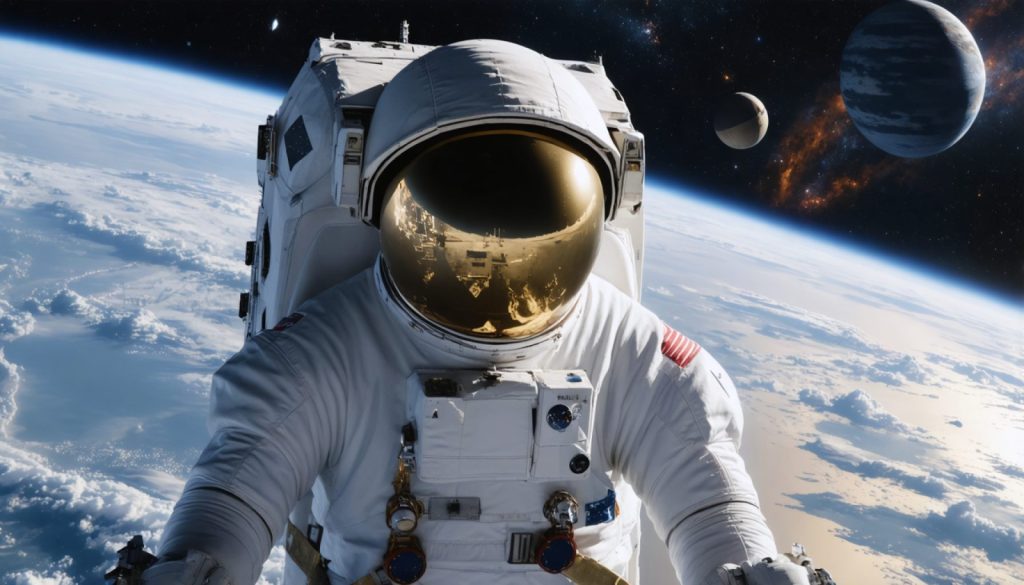
- SpaceX, led by Elon Musk, aims to make space travel as accessible as air travel by reducing costs and making ambitious space missions possible.
- The Falcon 9 rocket, known for its reusability, has drastically lowered the costs of space exploration, paving the way for sustainable space travel.
- SpaceX’s Starlink initiative seeks to provide global high-speed internet, especially benefiting remote areas lacking traditional connectivity.
- SpaceX is advancing human exploration with the Starship, designed to carry humans to Mars and facilitate future colonization efforts.
- Each SpaceX mission expands the possibilities of human life beyond Earth, moving us closer to a future where space travel is not a fantasy but a reality.
- SpaceX’s innovations unite humanity in the shared vision of breaking celestial barriers and exploring the cosmos.
Beneath the vast, star-studded sky, SpaceX is not just reaching for the stars; it’s redefining what humanity can achieve in the cosmos. Elon Musk’s visionary company has embarked on an ambitious voyage, igniting imaginations and challenging the very frontiers of space travel.
Few endeavors have captured the world’s imagination as vividly as SpaceX’s audacious mission to make space travel as commonplace as air travel. Spearheaded by the unrelenting ambition of Musk, SpaceX aims to lower the costs of spaceflight, making the aspiration of moon bases and Mars colonies not just fictional musings but tangible futures.
Revolutionizing Rocketry
Like a modern myth, the Falcon 9, a reusable rocket, has revolutionized the world of space exploration. Instead of leaving expensive hardware to drift endlessly, SpaceX’s engineering prowess enables the Falcon 9 to return to Earth, its boosters descending back to land or bobbing gently on drone ships with precision. This game-changing technology has drastically reduced costs, paving the way for sustainable space travel.
Imagine a sleek rocket ascending gracefully against the blue canvas of Earth’s sky, only to return subtly to a floating platform in the ocean—they named it “Of Course I Still Love You”—in homage to the longevity of their ambitions. Such poetic nods intertwined with high-tech achievements embody the spirit of SpaceX.
Satellite Revolution
Not content with redefining rockets, SpaceX has turned its eyes toward the skies with Starlink, an ambitious plan to envelope the globe with high-speed internet. With hundreds of satellites already in orbit, the endeavor promises to bridge the digital divide, delivering connectivity to remote corners of the world where cables dare not tread.
Sowing Seeds on Mars
The adept architects at SpaceX have set their course for Mars. The mighty Starship, a rocket as tall as skyscrapers, designed to carry humans and cargo to the Martian surface, stands as a testament to the potential for human colonization of other planets. Each test flight brings us one step closer to realizing the dream of interplanetary life.
The Takeaway: A New Era Dawns
SpaceX stands as a testament to human ingenuity. With each launch, and each touchdown, it sends a clear message: the era when human life expands beyond our blue planet is not a fantasy, but a fledgling reality. As SpaceX’s rockets continue to crack the sky, so too will the limits of our imagination broaden, and our dreams for the cosmos’ bounty become that much closer to our reach.
SpaceX is not just about rockets and satellites; it’s about creating a future where the barriers of distance and celestial frontiers crumble, uniting humanity under a shared vision of exploration and discovery. In the silent vastness of space, SpaceX’s whispering engines declare a bold new dawn for humankind.
SpaceX: Transforming Space Travel and Connectivity for a New Era
Expanding Beyond the Horizons
SpaceX has rapidly altered the landscape of space travel and satellite technology, pushing the boundaries of what was once considered possible. Here’s a deeper dive into the pivotal advancements, applications, and future prospects of Elon Musk’s groundbreaking venture.
Revolutionizing Rocketry with Falcon 9
The Falcon 9: A Technical Marvel
The Falcon 9 rocket is more than just a symbol of innovation; it’s a model of efficiency in rocketry. The reusability of its first stage dramatically reduces costs, allowing SpaceX to offer competitive pricing for satellite launches and resupply missions to the International Space Station (ISS). According to NASA, a single Falcon 9 launch can cost significantly less than traditional rockets, making space missions financially viable on a larger scale.
Sustainability and Environmental Impact
Reusable rockets not only cut costs but also minimize the environmental footprint of space missions. Fewer launches result in reduced carbon emissions and less debris in space, aligning with global sustainability goals.
Starlink: Bridging the Digital Divide
Global Internet Access
Starlink has the potential to transform global communication by providing high-speed internet to underserved areas. With over 4,200 satellites expected to be in orbit as part of its initial constellation (as of 2023), Starlink aims to offer low-latency, broadband internet globally, supporting initiatives in education, healthcare, and disaster response.
Real-World Applications and Controversies
While Starlink promises significant connectivity advances, it has faced criticism regarding space debris and light pollution. The impact on astronomical observations is a particular concern, with experts working on solutions to reduce reflectivity and improve satellite deorbiting protocols (https://www.thespacereview.com).
Preparing Humanity for Mars
Starship: Pioneering Interplanetary Travel
Starship represents SpaceX’s vision for human settlement on Mars, capable of ferrying up to 100 passengers and large volumes of cargo. Its development includes rigorous testing phases to perfect cruising, landing, and relaunching capabilities, vital for establishing a sustainable human presence on Mars.
Challenges and Predictions
Human colonization of Mars faces challenges including radiation exposure, life support systems, and sustainable resource management. Experts predict that overcoming these hurdles will require international collaboration and advancements in technology.
Market Trends and Future Prospects
Commercial Space Travel Industry
The burgeoning commercial space travel industry is expected to reach $3 billion by 2030, driven by declining launch costs and increased private and government investments (reports from the Space Foundation). SpaceX is leading this charge, challenging competitors like Blue Origin and Rocket Lab to innovate.
Actionable Recommendations for Aspiring Space Enthusiasts
1. Stay Informed: Follow updates from SpaceX and other space agencies to understand ongoing missions and innovations.
2. Pursue STEM Education: With space technology rapidly advancing, skills in science, technology, engineering, and mathematics can lead to exciting career opportunities.
3. Support Sustainability Efforts: Advocate for policies that balance technological innovation with environmental preservation.
Final Thoughts
SpaceX’s relentless pursuit of space exploration reshapes not only the cosmos but the future of human opportunity. With each achievement, it underscores the boundless potential of combining visionary goals with cutting-edge technology.
For further insights on space advancements and to join the conversation, visit SpaceX.



